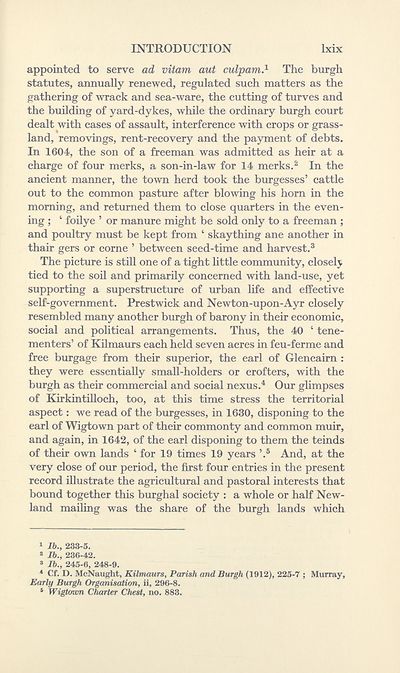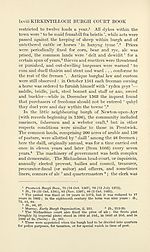Series 3 > Court book of the Burgh of Kirkintilloch 1658-1694
(76) Page lxix
Download files
Complete book:
Individual page:
Thumbnail gallery: Grid view | List view

INTRODUCTION
Ixix
appointed to serve ad vitam aut culpam.1 The burgh
statutes, annually renewed, regulated such matters as the
gathering of wrack and sea-ware, the cutting of turves and
the building of yard-dykes, while the ordinary burgh court
dealt with cases of assault, interference with crops or grass¬
land, removings, rent-recovery and the payment of debts.
In 1604, the son of a freeman was admitted as heir at a
charge of four merks, a son-in-law for 14 merks.2 In the
ancient manner, the town herd took the burgesses’ cattle
out to the common pasture after blowing his horn in the
morning, and returned them to close quarters in the even¬
ing ; ‘ foilye ’ or manure might be sold only to a freeman ;
and poultry must be kept from ‘ skaything ane another in
thair gers or corne ’ between seed-time and harvest.3
The picture is still one of a tight little community, closely
tied to the soil and primarily concerned with land-use, yet
supporting a superstructure of urban life and effective
self-government. Prestwick and Newton-upon-Ayr closely
resembled many another burgh of barony in their economic,
social and political arrangements. Thus, the 40 ‘ tene-
menters’ of Kilmaurs each held seven acres in feu-ferme and
free burgage from their superior, the earl of Glencairn :
they were essentially small-holders or crofters, with the
burgh as their commercial and social nexus.4 Our glimpses
of Kirkintilloch, too, at this time stress the territorial
aspect: we read of the burgesses, in 1630, disponing to the
earl of Wigtown part of their commonty and common muir,
and again, in 1642, of the earl disponing to them the teinds
of their own lands ‘ for 19 times 19 years \5 And, at the
very close of our period, the first four entries in the present
record illustrate the agricultural and pastoral interests that
bound together this burghal society : a whole or half New-
land mailing was the share of the burgh lands which
1 lb., 233-5.
2 lb., 236-42.
3 lb., 245-6, 248-9.
4 Cf. D. McNaught, Kilmaurs, Parish and Burgh (1912), 225-7 ; Murray,
Early Burgh Organisation, ii, 296-8.
6 Wigtown Charter Chest, no. 883.
Ixix
appointed to serve ad vitam aut culpam.1 The burgh
statutes, annually renewed, regulated such matters as the
gathering of wrack and sea-ware, the cutting of turves and
the building of yard-dykes, while the ordinary burgh court
dealt with cases of assault, interference with crops or grass¬
land, removings, rent-recovery and the payment of debts.
In 1604, the son of a freeman was admitted as heir at a
charge of four merks, a son-in-law for 14 merks.2 In the
ancient manner, the town herd took the burgesses’ cattle
out to the common pasture after blowing his horn in the
morning, and returned them to close quarters in the even¬
ing ; ‘ foilye ’ or manure might be sold only to a freeman ;
and poultry must be kept from ‘ skaything ane another in
thair gers or corne ’ between seed-time and harvest.3
The picture is still one of a tight little community, closely
tied to the soil and primarily concerned with land-use, yet
supporting a superstructure of urban life and effective
self-government. Prestwick and Newton-upon-Ayr closely
resembled many another burgh of barony in their economic,
social and political arrangements. Thus, the 40 ‘ tene-
menters’ of Kilmaurs each held seven acres in feu-ferme and
free burgage from their superior, the earl of Glencairn :
they were essentially small-holders or crofters, with the
burgh as their commercial and social nexus.4 Our glimpses
of Kirkintilloch, too, at this time stress the territorial
aspect: we read of the burgesses, in 1630, disponing to the
earl of Wigtown part of their commonty and common muir,
and again, in 1642, of the earl disponing to them the teinds
of their own lands ‘ for 19 times 19 years \5 And, at the
very close of our period, the first four entries in the present
record illustrate the agricultural and pastoral interests that
bound together this burghal society : a whole or half New-
land mailing was the share of the burgh lands which
1 lb., 233-5.
2 lb., 236-42.
3 lb., 245-6, 248-9.
4 Cf. D. McNaught, Kilmaurs, Parish and Burgh (1912), 225-7 ; Murray,
Early Burgh Organisation, ii, 296-8.
6 Wigtown Charter Chest, no. 883.
Set display mode to:
![]() Universal Viewer |
Universal Viewer | ![]() Mirador |
Large image | Transcription
Mirador |
Large image | Transcription
Images and transcriptions on this page, including medium image downloads, may be used under the Creative Commons Attribution 4.0 International Licence unless otherwise stated. ![]()
| Scottish History Society volumes > Series 3 > Court book of the Burgh of Kirkintilloch 1658-1694 > (76) Page lxix |
|---|
| Permanent URL | https://digital.nls.uk/126714075 |
|---|
| Attribution and copyright: |
|
|---|
| Description | Over 180 volumes, published by the Scottish History Society, containing original sources on Scotland's history and people. With a wide range of subjects, the books collectively cover all periods from the 12th to 20th centuries, and reflect changing trends in Scottish history. Sources are accompanied by scholarly interpretation, references and bibliographies. Volumes are usually published annually, and more digitised volumes will be added as they become available. |
|---|


